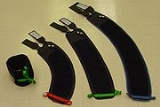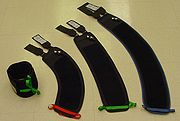
Surgical tourniquet
Encyclopedia
Surgical tourniquets enable surgeons to work in a bloodless operative field by preventing blood flow to a limb. This allows surgical procedures to be performed with improved precision, safety and speed. Tourniquet
s are widely used in orthopedic
and plastic surgery
, as well as in intravenous regional anesthesia
(Bier block anesthesia) where they serve the additional function of preventing local anesthetic in the limb from entering general circulation.
In the early 1980s, microprocessor-controlled pneumatic tourniquets were invented by Dr. James McEwen
, PhD . Automatic tourniquets based on this invention are now standard equipment in operating rooms worldwide, and these systems have significantly improved the safety and convenience of tourniquet use.
Despite many advances in tourniquet technology, tourniquet-related injuries continue to be of concern. High pressures under a tourniquet cuff can cause nerve, muscle and skin injury. Minimizing tourniquet pressure, reducing inflation time and using a microprocessor-controlled pneumatic tourniquet, which allows pressure to be accurately monitored and controlled, reduce the risk of tourniquet-related injury.
to the operative site. Pressure is exerted on the circumference of the limb by means of compressed gas which is introduced into the tourniquet cuff by a microprocessor-controlled source, via connection tubing. When sufficient pressure is exerted, vessels and arteries beneath the cuff become temporarily occluded
, preventing blood flow past the cuff. While the cuff is inflated, the tourniquet system automatically monitors and maintains the pressure chosen by the user. Cuff pressure and inflation time are displayed, and an audiovisual alarm alerts the user to alarm conditions, such as a cuff leak.
 Studies have shown that tourniquet cuff pressures can be substantially reduced without compromising the quality of surgical field by using wide, contoured cuffs. Wide cuffs also reduce the risk of injury to underlying tissue by dispersing the cuff’s force over a greater surface area. Standard cuffs are relatively narrow in width and are cylindrical in shape. Where there is a significant difference in limb circumference between the distal
Studies have shown that tourniquet cuff pressures can be substantially reduced without compromising the quality of surgical field by using wide, contoured cuffs. Wide cuffs also reduce the risk of injury to underlying tissue by dispersing the cuff’s force over a greater surface area. Standard cuffs are relatively narrow in width and are cylindrical in shape. Where there is a significant difference in limb circumference between the distal
and proximal
edges of the cuff, a contoured cuff with a tapered, conical shape provides a more anatomical fit and maximizes the contact area between cuff and limb. Wide cuffs with an adjustable, variable taper have recently been introduced, permitting one cuff to conform to a variety of limb shapes.
blood flow to a specific patient's limb at a specific time, and takes into account a patient’s limb and vessel characteristics, and the type and fit of the cuff. LOP can be determined by gradually increasing tourniquet pressure until distal
arterial pulses cease, as indicated by a device sensing blood flow, such as a Doppler stethoscope
. Studies have shown that cuff pressure based on LOP measured immediately prior to surgery is generally lower than pressure from commonly used cuffs and is sufficient to maintain a satisfactory surgical field. Traditionally, this method has not been used because it is time consuming and technically demanding. However, a pneumatic tourniquet that uses an automated plethysmograph
ic system to calculate LOP in approximately 30 seconds at the beginning of surgery has recently been developed. This device has similar accuracy to the standard Doppler technique and addresses the practicality of using LOP in the operating room.
 For some cuffs, a matching limb protection sleeve is available to help protect soft tissues under the cuff. Without proper protection, underlying soft tissue is prone to damage caused by wrinkling, pinching or shearing. Sleeves are sized according to the cuff width and the patient’s limb circumference. They are intended to fit snugly and extend beyond the edge of the cuff to ensure that there is no direct contact between cuff and skin. Sleeve materials that do not shed loose fibers are chosen to avoid lint becoming trapped in the cuff’s hook and loop fasteners, which reduces their effectiveness.
For some cuffs, a matching limb protection sleeve is available to help protect soft tissues under the cuff. Without proper protection, underlying soft tissue is prone to damage caused by wrinkling, pinching or shearing. Sleeves are sized according to the cuff width and the patient’s limb circumference. They are intended to fit snugly and extend beyond the edge of the cuff to ensure that there is no direct contact between cuff and skin. Sleeve materials that do not shed loose fibers are chosen to avoid lint becoming trapped in the cuff’s hook and loop fasteners, which reduces their effectiveness.
Tourniquet
An emergency tourniquet is a tightly tied band applied around a body part sometimes used in an attempt to stop severe traumatic bleeding. Tourniquets are also used during venipuncture and other medical procedures. Severe bleeding means the loss of more than 1,000 ml of blood. This flow of blood...
s are widely used in orthopedic
Orthopedic surgery
Orthopedic surgery or orthopedics is the branch of surgery concerned with conditions involving the musculoskeletal system...
and plastic surgery
Plastic surgery
Plastic surgery is a medical specialty concerned with the correction or restoration of form and function. Though cosmetic or aesthetic surgery is the best-known kind of plastic surgery, most plastic surgery is not cosmetic: plastic surgery includes many types of reconstructive surgery, hand...
, as well as in intravenous regional anesthesia
Intravenous regional anesthesia
Intravenous regional anesthesia or Bier block anesthesia is a common anesthetic technique for surgical procedures on the body's extremities where a local anesthetic is injected intravenously. The technique usually involves exsanguination, which forces blood out of the extremity, followed by the...
(Bier block anesthesia) where they serve the additional function of preventing local anesthetic in the limb from entering general circulation.
In the early 1980s, microprocessor-controlled pneumatic tourniquets were invented by Dr. James McEwen
James McEwen (engineer)
James McEwen is a biomedical engineer and the inventor of the microprocessor-controlled automatic tourniquet system, which is now standard for 15,000-20,000 procedures daily in operating rooms worldwide. He is also an adjunct professor in the Faculty of Orthopaedics and the Faculty of Electrical...
, PhD . Automatic tourniquets based on this invention are now standard equipment in operating rooms worldwide, and these systems have significantly improved the safety and convenience of tourniquet use.
Despite many advances in tourniquet technology, tourniquet-related injuries continue to be of concern. High pressures under a tourniquet cuff can cause nerve, muscle and skin injury. Minimizing tourniquet pressure, reducing inflation time and using a microprocessor-controlled pneumatic tourniquet, which allows pressure to be accurately monitored and controlled, reduce the risk of tourniquet-related injury.
Surgical tourniquet equipment
Modern pneumatic tourniquets have three basic components: an inflatable cuff, a compressed gas source, and an instrument which automatically monitors and controls cuff pressure. The cuff is secured around the limb proximalAnatomical terms of location
Standard anatomical terms of location are designations employed in science that deal with the anatomy of animals to avoid ambiguities that might otherwise arise. They are not language-specific, and thus require no translation...
to the operative site. Pressure is exerted on the circumference of the limb by means of compressed gas which is introduced into the tourniquet cuff by a microprocessor-controlled source, via connection tubing. When sufficient pressure is exerted, vessels and arteries beneath the cuff become temporarily occluded
Vascular occlusion
Vascular occlusion is a sudden blockage of a blood vessel, usually with a clot. It differs from thrombosis in that it can be used to describe any form of blockage, not just one formed by a clot. When it occurs in a major vein, it can, in some cases, cause deep vein thrombosis. The condition is...
, preventing blood flow past the cuff. While the cuff is inflated, the tourniquet system automatically monitors and maintains the pressure chosen by the user. Cuff pressure and inflation time are displayed, and an audiovisual alarm alerts the user to alarm conditions, such as a cuff leak.
Contoured cuffs

Anatomical terms of location
Standard anatomical terms of location are designations employed in science that deal with the anatomy of animals to avoid ambiguities that might otherwise arise. They are not language-specific, and thus require no translation...
and proximal
Anatomical terms of location
Standard anatomical terms of location are designations employed in science that deal with the anatomy of animals to avoid ambiguities that might otherwise arise. They are not language-specific, and thus require no translation...
edges of the cuff, a contoured cuff with a tapered, conical shape provides a more anatomical fit and maximizes the contact area between cuff and limb. Wide cuffs with an adjustable, variable taper have recently been introduced, permitting one cuff to conform to a variety of limb shapes.
Limb occlusion pressure
Limb occlusion pressure (LOP) is the minimum tourniquet pressure required to occludeVascular occlusion
Vascular occlusion is a sudden blockage of a blood vessel, usually with a clot. It differs from thrombosis in that it can be used to describe any form of blockage, not just one formed by a clot. When it occurs in a major vein, it can, in some cases, cause deep vein thrombosis. The condition is...
blood flow to a specific patient's limb at a specific time, and takes into account a patient’s limb and vessel characteristics, and the type and fit of the cuff. LOP can be determined by gradually increasing tourniquet pressure until distal
Anatomical terms of location
Standard anatomical terms of location are designations employed in science that deal with the anatomy of animals to avoid ambiguities that might otherwise arise. They are not language-specific, and thus require no translation...
arterial pulses cease, as indicated by a device sensing blood flow, such as a Doppler stethoscope
Stethoscope
The stethoscope is an acoustic medical device for auscultation, or listening to the internal sounds of an animal body. It is often used to listen to lung and heart sounds. It is also used to listen to intestines and blood flow in arteries and veins...
. Studies have shown that cuff pressure based on LOP measured immediately prior to surgery is generally lower than pressure from commonly used cuffs and is sufficient to maintain a satisfactory surgical field. Traditionally, this method has not been used because it is time consuming and technically demanding. However, a pneumatic tourniquet that uses an automated plethysmograph
Plethysmograph
A plethysmograph is an instrument for measuring changes in volume within an organ or whole body .-Lungs:...
ic system to calculate LOP in approximately 30 seconds at the beginning of surgery has recently been developed. This device has similar accuracy to the standard Doppler technique and addresses the practicality of using LOP in the operating room.
Limb protection

External links
- Delfi Medical specialty tourniquets
- Automatic tourniquets
- Tourniquets.org
- Association of Perioperative Registered Nurses
- http://www.frontiermedicalproducts.com Frontier Medical Products surgical tourniquets

